
Hoodia is a genus of flowering plants in the family Apocynaceae, under the subfamily Asclepiadoideae, native to Southern Africa.

Stapeliinae is a subtribe of flowering plants within the tribe Ceropegieae of the subfamily Asclepiadoideae of the family Apocynaceae. The subtribe comprises about 35 genera, including both the stem-succulent "stapeliads" and the horticulturally popular genera Brachystelma and Ceropegia. The largest number of genera are native to Africa, but a more limited number of genera are widespread in Arabia and Asia. Historically, a similarly circumscribed taxon was treated as a separate tribe, Stapelieae.

The genus Huernia consists of perennial, stem succulents from Eastern and Southern Africa and Arabia, first described as a genus in 1810.
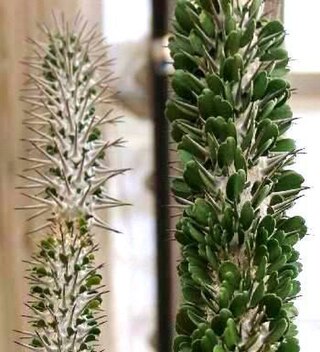
Didiereaceae is a family of flowering plants found in continental Africa and Madagascar. It contains 20 species classified in three subfamilies and six genera. Species of the family are succulent plants, growing in sub-arid to arid habitats. Several are known as ornamental plants in specialist succulent collections. The subfamily Didiereoideae is endemic to the southwest of Madagascar, where the species are characteristic elements of the spiny thickets.

Duvalia is a succulent plant genus in the subfamily Asclepiadoideae, in the family Apocynaceae (dogbane).

Portulacaria is a genus of succulent plant, classified in its own subfamily Portulacarioideae in the family Didiereaceae. It is indigenous to southern Africa.
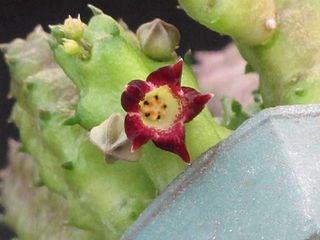
Baynesia is a genus of flowering plants in the family Apocynaceae. Its only species is Baynesia lophophora, endemic to Namibia. It was first discovered by Peter Bruyns in 1999, and first described by him in 2000.

Cerberiopsis is a genus of plant in the family Apocynaceae, first described as a genus in 1873. The entire group is endemic to New Caledonia. The genus is related to Cerbera.
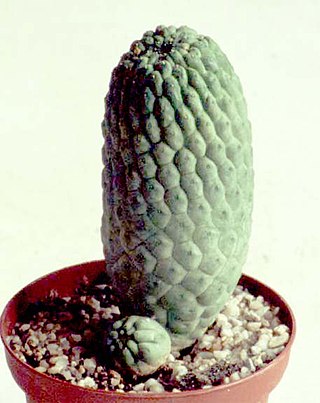
Larryleachia is a genus of stapeliad succulent flowering plants in the family Apocynaceae.

Lavrania is a monospecific genus of plants in family Apocynaceae. Its only species is Lavrania haagnerae, endemic to Namibia. Its natural habitat is rocky areas.

Pseudolithos is a genus of succulent flowering plants of the family Apocynaceae, indigenous to arid areas of Somalia, Yemen and Oman.

Tavaresia is a genus of plants in the family Apocynaceae, first described as a genus in 1902. It is native to southern Africa.
- Tavaresia angolensisWelw. - Angola
- Tavaresia barklyi(Dyer) N.E.Br. - South Africa
- Tavaresia grandifloraBerger - South Africa
- Tavaresia meintjesiiR.A. Dyer - Limpopo

Echidnopsis is a genus of succulent, cactus-like plants in the family Apocynaceae, first described as a genus in 1871. They are native to eastern Africa and the Arabian Peninsula.

Piaranthus is a succulent plant genus in the subfamily Asclepiadoideae, in the family Apocynaceae.
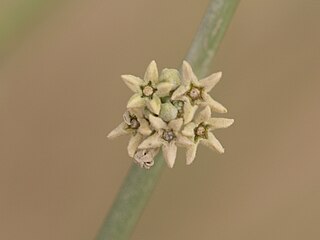
Leptadenia is a genus of plants in the family Apocynaceae, first described as a genus in 1810. It is native to Africa, including Madagascar, as well as southwest Asia and the Indian Subcontinent.
- Leptadenia arborea(Forssk.) Schweinf. - Sudan, Ethiopia
- Leptadenia lancifolia(Schumach. & Thonn.) Decne. - tropical Africa
- Leptadenia madagascariensisDecne. - Madagascar
- Leptadenia pyrotechnica(Forssk.) Decne. - widespread from Algeria to India
- Leptadenia reticulata(Retz.) Wight & Arn. - Madagascar
Notechidnopsis is a group of plants in the family Apocynaceae first described as a genus in 1985. It contains only one recognized species, Notechidnopsis tessellata, native to Cape Province in South Africa.
Pentopetia is a plant genus in the family Apocynaceae, first described as a genus in 1844.
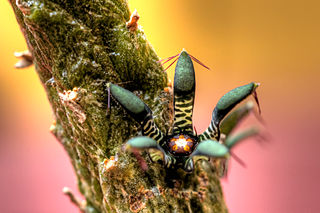
Rhytidocaulon is a plant genus in the family Apocynaceae, first described in 1962. It is native to northeastern Africa and the Arabian Peninsula
Pervillaea is a genus of plants in the family Apocynaceae, first described as a genus in 1844. It is native to Mauritius and Madagascar in the Indian Ocean.
- Pervillaea brevirostrisKlack. - Mauritius
- Pervillaea decaryi(Choux) Klack. - Madagascar
- Pervillaea phillipsoniiKlack. - Madagascar
- Pervillaea tomentosaDecne. - Madagascar
- Pervillaea venenata(Baill.) Klack. - Madagascar
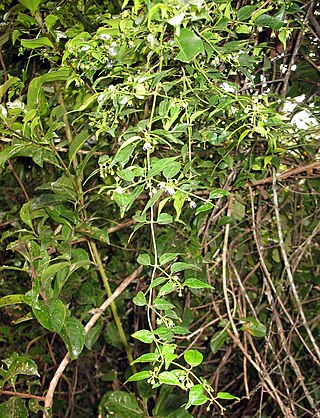
Camptocarpus acuminatus is a species of plant in the Apocynaceae family. It is endemic to the Madagascar. Pierre Choux, the botanist who first formally described the species, named it after the tapering tips of its leaves, using the synonymous name Tanulepis acuminata.

















